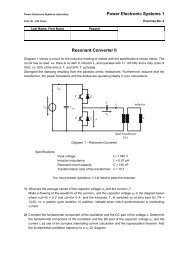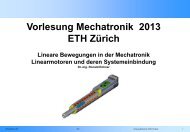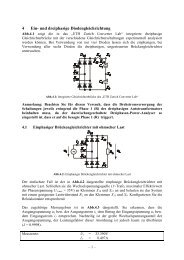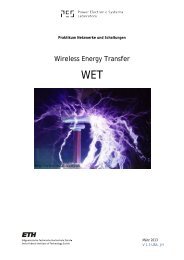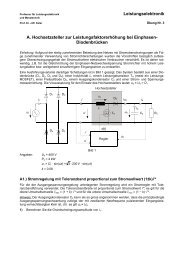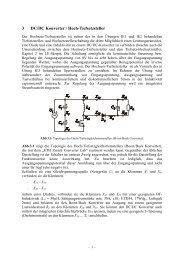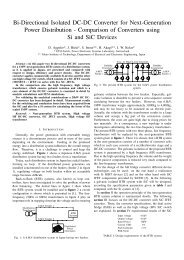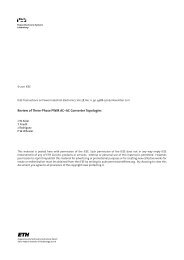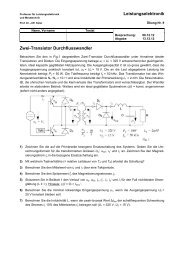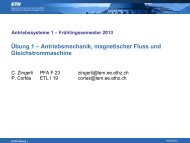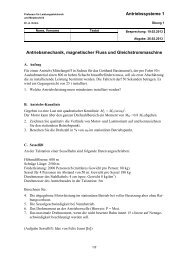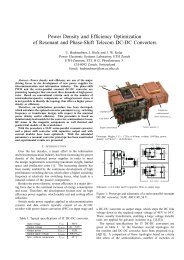Novel High-Speed, Lorentz-Type, Slotless Self-Bearing Motor
Novel High-Speed, Lorentz-Type, Slotless Self-Bearing Motor
Novel High-Speed, Lorentz-Type, Slotless Self-Bearing Motor
You also want an ePaper? Increase the reach of your titles
YUMPU automatically turns print PDFs into web optimized ePapers that Google loves.
<strong>Novel</strong> <strong>High</strong>-<strong>Speed</strong>, <strong>Lorentz</strong>-<strong>Type</strong>, <strong>Slotless</strong> <strong>Self</strong>-<br />
<strong>Bearing</strong> <strong>Motor</strong><br />
T.I. Baumgartner, A. Looser, C. Zwyssig, and J.W. Kolar<br />
Power Electronic Systems Laboratory<br />
ETH Zurich<br />
CH-8092 Zurich, Switzerland<br />
baumgartner@lem.ee.ethz.ch<br />
Abstract — Active magnetic bearings are a preferred choice for<br />
supporting rotors spinning at high-speed due to low friction<br />
losses and no wear. However, the rotational speed in previous<br />
bearing topologies has been limited by complex rotor<br />
constructions, high rotor losses, or position control instabilities at<br />
high speed. This paper presents a novel <strong>Lorentz</strong>-type, slotless<br />
self-bearing motor concept which overcomes most limitations of<br />
previously presented high-speed AMBs. An analytical model for<br />
motor torque and bearing forces is presented and a design for<br />
500 000 rpm is verified with FE simulations, showing<br />
exceptionally low negative stiffness cross coupling. Finally, a<br />
prototype system is described.<br />
I. INTRODUCTION<br />
Ultra-high-speed electrical drive systems are developed for<br />
new emerging applications, such as generators/starters for<br />
micro gas turbines, turbo-compressor systems, drills for medical<br />
applications, and spindles for machining and optical<br />
applications. Typically, the power ratings of these applications<br />
range from a few watts to a few kilowatts, and the speeds from<br />
a few tens of thousands of rpm up to a million rpm, which<br />
results in machine rotor diameters in the Millimeter area [1].<br />
The biggest remaining challenge is a bearing that can support<br />
such rotors with low losses and a long lifetime. The active<br />
magnetic bearing (AMB) is a preferred choice due to the<br />
contactless operation which leads to low friction losses and no<br />
wear, the ability to operate in vacuum, and the controllability<br />
which allows for cancellation or damping of instabilities.<br />
There are several feasibility studies and theoretical designs<br />
for high-speed magnetic bearings, such as a 500 000 rpm<br />
homopolar AMB concept in [2] and a comparison of long and<br />
short AMB rotors in [3]. However, there are only few<br />
publications with experimental results. [4] achieved a speed of<br />
64 000 rpm with a heteropolar bearing and a homopolar<br />
bearing in [5] ran at 120 000 rpm.<br />
To the authors knowledge no AMB presented in literature<br />
has achieved rotational speeds above 120 000 rpm, the biggest<br />
challenges are the high rotor losses, the disintegration of the<br />
rotor due to a complex rotor structure, and instabilities due to<br />
high frequency excitation and limited controller bandwidth.<br />
Therefore, in this paper, a novel slotless self-bearing motor<br />
topology (Figure 1) is presented allowing for ultra-high speed<br />
operation. It overcomes most of the limitations of previously<br />
presented high-speed AMBs, which are usually due to the<br />
bearing topology. The novel bearing is analyzed analytically,<br />
and a design for 500 000 rpm is verified with FE simulations.<br />
II. NOVEL SELF-BEARING MOTOR<br />
The basic concept of a self-bearing (also called<br />
bearingless) motor has been presented in 0 for a reluctance<br />
motor and has been adopted for slotted permanent-magnet<br />
motors in [7] and for a slice motor in [8]. There have been a<br />
few attempts for high-speed self-bearing motors, and in [9] a<br />
speed of 60 000 rpm has been achieved.<br />
An early reference to a <strong>Lorentz</strong>-type bearing can be found<br />
in [10], slotless <strong>Lorentz</strong>-type bearing prototypes have been<br />
presented in [11] for positioning applications and in [12] for<br />
mirrors in laser applications. [13] is the first to mention the<br />
high-speed potential of a slotless self-bearing motor, although<br />
the prototype presented rotates at only 5 000 rpm.<br />
The magnetic bearing concept presented in this paper is<br />
based on the electric machine concept presented in [14]. With<br />
a different winding design, forces in x and y direction can be<br />
generated beside the torque in direction of the z-axis. In order<br />
to levitate a long rotor, two separate bearing windings<br />
separated in z direction are required.<br />
y<br />
<strong>Motor</strong> winding<br />
<strong>Bearing</strong> winding<br />
Stator core<br />
Air gap<br />
Permanent magnet<br />
r<br />
θ<br />
R 1<br />
R Fw1<br />
R Fw2<br />
R 2<br />
R 4<br />
R 5<br />
Sleeve<br />
Figure 1. Machine cross-section and symbol definitions: diametrically<br />
magnetized cylindrical permanent magnet rotor inside a slotless stator with<br />
separate bearing and motor winding.<br />
x<br />
978-1-4244-5287-3/10/$26.00 ©2010 IEEE 3971
This concept has several advantages for high-speed<br />
operation. The rotor consists of a diametrically magnetized,<br />
two-pole ( p M = 1) cylindrical permanent magnet encased in a<br />
nonmagnetic sleeve. Mechanically, this rotor construction<br />
allows for highest rotational speeds even with large rotor<br />
diameters. Furthermore, the slotless air-gap winding has<br />
several advantages for high-speed operation: no slotting<br />
harmonics in the air-gap field, which in other AMB topologies<br />
lead to large eddy-current losses in the rotor, a constant<br />
magnetic air-gap and a high rotational symmetry leading to<br />
linear forces. With a thick winding the magnetic air-gap<br />
between rotor magnet and stator iron can be made large such<br />
that a very low negative stiffness results, which reduces the<br />
position control complexity. Furthermore, a large magnetic<br />
air-gap leads to a low inductivity, which allows for high<br />
dynamics in current control which is required at high<br />
rotational speeds. Finally, the magnetic flux density in the<br />
stator iron will be low and therefore also the iron losses.<br />
The motor winding for the torque generation has the same<br />
number of pole-pairs ( pT = pM<br />
) as the rotor, whereas the<br />
bearing winding has to be pF<br />
= pM<br />
+ / − 1 according to [15].<br />
In the concept presented here the pole-pair of the bearing<br />
winding is chosen to be p F = 2 in order to achieve the lowest<br />
possible fundamental frequency. The two windings can be<br />
combined or separated as shown in Figure 1. In electric<br />
machines the large stray fields in a slotless machine not<br />
entering the stator iron are a disadvantage. This changes to an<br />
advantage in the self-bearing motor as these stray fields add to<br />
the bearing force. Due to that, if the windings are separated,<br />
the bearing winding should be placed on the inner side where<br />
the stray field is larger, and the torque winding should be<br />
placed on the outer side where the moment arm is longer.<br />
Beside the many advantages, there are also a few<br />
drawbacks of the presented topology. As in all self-bearing<br />
motors the bearing currents are depending on the rotor angle<br />
for a constant force in one direction. Therefore, firstly the<br />
rotor angle is required and secondly, the bearing currents show<br />
a fundamental frequency depending on the rotational speed n,<br />
in this topology ( pT<br />
= pM<br />
= 1 p 2 , F = ) it is n /60. This<br />
leads to the requirement of high inverter dynamics, a fast<br />
transformation between stationary and rotating reference<br />
frames, and angle and current measurements with a high<br />
accuracy and a bandwidth depending on the rotational<br />
frequency. Furthermore, the achievable bearing forces are<br />
small compared to other AMBs with the same rotor radius and<br />
length. However, the limited force is not degrading the control<br />
stability, as it comes along with a very low negative stiffness<br />
as mentioned before. A further disadvantage is that the bearing<br />
forces are applied in the axial center of the bearing winding,<br />
penalizing the rotor dynamic design, ideally they should act on<br />
each end of the rotor.<br />
III. ANALYTICAL CALCULATIONS<br />
The following discussion of the magnetic field is based on<br />
the magnetostatic analytic field solution as in [16] and [14] for<br />
a permanent magnet with pole-pair number p M = 1. In<br />
cylindrical coordinates ( r, θ , z)<br />
the magnetic field in the nonferromagnetic<br />
region ( R1 < r < R4)<br />
is given by<br />
B<br />
⎡<br />
2<br />
4<br />
2 1 ⎛R<br />
⎞<br />
r = KB ⎢ + ⎥ cos − M<br />
⎢⎣<br />
⎜<br />
⎝<br />
⎤<br />
r<br />
⎟<br />
⎠ ⎥⎦<br />
( θ ϕ )<br />
, (1)<br />
⎡ 2<br />
4<br />
2 1 ⎛R<br />
⎞ ⎤<br />
Bθ =−KB<br />
⎢ −⎜<br />
⎥ sin ( θ −ϕM<br />
)<br />
r<br />
⎟<br />
⎢ ⎝ ⎠ ⎥<br />
. (2)<br />
⎣ ⎦<br />
The constants K B2<br />
and R 4 are defined according to [14]. ϕ M<br />
is the pole orientation of the permanent magnet. It is assumed<br />
that the axial component of the magnetic flux density B z is<br />
very small and can therefore be neglected. This assumption is<br />
valid when the active length of the motor L is large compared<br />
to its diameter. Furthermore, it is assumed that the magnetic<br />
field resulting from winding currents is small compared to the<br />
permanent-magnet field and can be omitted as well. The<br />
<strong>Lorentz</strong>-force and the torque density are given by<br />
dFk<br />
jk<br />
B<br />
dV = × <br />
, (3)<br />
dM<br />
k ⎛dFk<br />
⎞<br />
= a ×<br />
dV<br />
⎜<br />
dV<br />
⎟ , (4)<br />
⎝ ⎠<br />
<br />
where j k is the winding current density in z direction The<br />
current density is constant over a winding segment k . a is the<br />
local position vector. The total <strong>Lorentz</strong>-force and torque on the<br />
rotor can be calculated by integration of the densities over the<br />
volume of each winding segment and summation over all<br />
segments as shown in (5) and (6).<br />
K L/2<br />
Rw2<br />
θk,2<br />
<br />
⎛dFk<br />
⎞<br />
F = ∑ ∫ ∫ ∫ ⎜ rdθ<br />
drdz<br />
dV<br />
⎟<br />
⎝ ⎠<br />
k = 1 z=− L/2<br />
r= Rw1 θ=<br />
θk,1<br />
K L/2<br />
Rw2<br />
θk<br />
,2<br />
<br />
⎛dM<br />
k ⎞<br />
M = ∑ ∫ ∫ ∫ ⎜ rdθ<br />
drdz<br />
dV<br />
⎟<br />
⎝ ⎠<br />
k = 1 z=− L/2<br />
r= Rw1 θ=<br />
θk,1<br />
A. <strong>Motor</strong> winding<br />
In order to generate a motor torque on the rotor, a one<br />
pole-pair, three-phase air-gap winding ( p T = 1, K = 6 ) is<br />
considered. The winding has an inner radius R Tw1<br />
and an<br />
outer radius RTw2<br />
and a copper filling factor k w . A<br />
symmetrical three phase current is defined with a current<br />
density amplitude ˆT j and a phase ϕ T . The force and torque<br />
of this winding can be obtained by solving (5) and (6) in<br />
Cartesian coordinates leading to<br />
⎡0⎤<br />
⎡ 0 ⎤<br />
<br />
F<br />
⎢<br />
T 0<br />
⎥ ⎢<br />
⎥<br />
=<br />
⎢ ⎥<br />
, MT = MT<br />
⎢<br />
0<br />
⎥<br />
, (7)<br />
⎢⎣0⎥⎦ ⎢<br />
⎣cos( ϕT<br />
−ϕM<br />
) ⎥<br />
⎦<br />
M ˆ<br />
T = Lkw jT KB2( RTw2 −RTw1)<br />
⋅<br />
(8)<br />
2 2 2<br />
3 R + R + R R + R .<br />
( 4 Tw1 Tw1 Tw2 Tw2)<br />
B. <strong>Bearing</strong> winding<br />
Radial bearing forces are generated by a two pole-pair,<br />
three-phase winding ( p F = 2 K = 12 ). The winding has an<br />
inner radius of R Fw1<br />
and an outer radius of R Fw2<br />
and a<br />
copper filling factor k w . A symmetrical three phase current is<br />
(5)<br />
(6)<br />
3972
defined with a current density amplitude ˆF j and a phase ϕ F .<br />
The resulting torque and <strong>Lorentz</strong> force is given by<br />
⎡ sin ( ϕF<br />
−ϕM<br />
) ⎤ ⎡0⎤<br />
⎢ ⎥ <br />
FF = FF cos ( ϕF ϕM ) , M<br />
⎢<br />
F 0<br />
⎥<br />
⎢− − ⎥ =<br />
⎢ ⎥<br />
, (9)<br />
⎢<br />
⎣ 0 ⎥<br />
⎦<br />
⎢⎣0<br />
⎥⎦<br />
ˆ 2 ⎛ RFw2<br />
⎞<br />
FF = 3Lkw jF KB2 R4<br />
ln ⎜ ⎟.<br />
(10)<br />
⎝ RFw1<br />
⎠<br />
This result indicates that the bearing force is linearly<br />
dependent on the magnitude of the bearing current ˆF j . Its<br />
direction is given by the angleϕ<br />
F − ϕ M . Thus, the bearing<br />
force can be controlled with a standard three phase inverter<br />
when a good estimation of the angular position of the rotor is<br />
available to the controller.<br />
C. Negative stiffness<br />
In this section the sensitivity of small rotor eccentricities is<br />
examined. When the rotor is displaced radially, a reluctance<br />
force dragging the rotor away from the centered position<br />
occurs. This is due to the unsymmetrical field distribution at<br />
the inner side of the iron core. This negative stiffness<br />
dFx<br />
kx<br />
= (11)<br />
dx<br />
is defined similar to a spring constant. Due to the rotational<br />
symmetry of the cross section k x = k y can be assumed. The<br />
negative stiffness is determined with evaluating Maxwell<br />
stress tensors in FEM field simulations.<br />
D. Winding inductances<br />
A major advantage of the proposed self-bearing motor is<br />
the low winding inductances. Therefore, reactive power is<br />
small and there is no need for high inverter dc link voltages to<br />
achieve high current control dynamics as in other AMBs.<br />
Contrariwise, an inverter topology and modulation has to be<br />
chosen that allows for lowest inductances. The inductance<br />
values given in Table I are calculated by means of magnetic<br />
energy integration in FEM field simulations.<br />
IV. WINDING OPTIMIZATION<br />
<strong>Lorentz</strong>-force based force and torque generation is<br />
primarily proportional to the winding currents and therefore<br />
limited by the resulting copper losses [12]. Therefore, for a<br />
given force and torque the minimization of the copper losses<br />
P π ˆ2 2 2<br />
Cu = w ( w2 w1)<br />
2<br />
Lk j R −<br />
σ<br />
R<br />
(12)<br />
cu<br />
is desired. For the following optimization considerations an<br />
approximate field solution<br />
2<br />
⎡ ⎤ Brem<br />
R1<br />
B2 = lim ⎢ lim KB2⎥<br />
=<br />
μ<br />
2<br />
r1→1<br />
⎣μr5→∞<br />
⎦ 2R4<br />
K (13)<br />
is used. It is assumed that the relative permeability of the back<br />
iron μ r5<br />
is considerably higher than in the air-gap, and that<br />
the relative permeability of the permanent magnet μr1<br />
is 1.<br />
Realistic values are in the order of μ r5 = 20000 and<br />
μ r1 = 1.05 (for amorphous iron and samarium–cobalt<br />
permanent magnets). Thus, only very small field errors result<br />
due to this approximation.<br />
A. <strong>Motor</strong> winding optimization<br />
Using (13), (8) can be simplified to<br />
2<br />
ˆ<br />
BremR1<br />
T w T 2 Tw2 Tw1<br />
2R4<br />
( )<br />
M<br />
= Lk j R −R<br />
⋅<br />
2 2 2<br />
( R4 + RTw1+ RTw1RTw2 + RTw2)<br />
3 .<br />
(14)<br />
Minimizing P Cu by varying the winding geometry R Tw1<br />
and<br />
R Tw2 for a given L , R 1 , R 4 , and a desired M T indicates that<br />
all available space (namely the air-gap) shall be filled by the<br />
torque winding. So ideally RTw1 = R2<br />
and RTw2 = R4. In<br />
practice this result is not applicable, because there has to be a<br />
clearance between the rotor and the stator. Furthermore, a<br />
radial bearing winding has to be integrated. This reduces the<br />
space available for the motor winding.<br />
B. <strong>Bearing</strong> winding optimization<br />
Using the approximation in (13) the bearing force<br />
magnitude is<br />
3<br />
ˆ 2 RFw2<br />
F ⎛ ⎞<br />
F = Lkw jF Brem<br />
R1<br />
ln ⎜ ⎟.<br />
(15)<br />
2<br />
⎝ RFw1<br />
⎠<br />
This result indicates that the bearing force does not depend on<br />
the inner radius of the back-iron. This is due to the fact that the<br />
stray field B θ adds to the bearing force generation. Increasing<br />
iron radius R 4 decreases the radial field B r but increases the<br />
tangential stray field B θ . These two effects compensate each<br />
other completely in the bearing force windings.<br />
For a given given L , R 1 , R 4 , and a desired F F the copper<br />
losses are proportional to<br />
R<br />
2<br />
Fw2<br />
( ) −<br />
RFw1<br />
RFw2<br />
ln ( R )<br />
1<br />
P ~ F R<br />
.<br />
(16)<br />
2 2<br />
Cu F Fw 1 2<br />
Fw1<br />
Minimizing P Cu by varying R Fw2<br />
and a constant R Fw1<br />
leads<br />
to<br />
RFw2<br />
= 2.2185 .<br />
(17)<br />
RFw1<br />
Therefore. the bearing winding has minimal copper losses if<br />
R Fw1 is chosen as small as possible and R Fw2<br />
is chosen<br />
according to (17). In contrary to the torque winding it is not<br />
optimal to fill the entire air-gap with the force winding.<br />
C. Joint bearing and motor winding optimization<br />
In order to be able to use standard three phase inverters for<br />
the motor and the bearing currents, a design is chosen with<br />
separate torque and force windings. A key advantage of using<br />
separate windings is the “decoupling” of force and torque<br />
generation. Their associated currents can be controlled by<br />
separate controllers. The bearing winding is placed as close as<br />
possible to the rotor. The motor winding fills the rest of the<br />
space between the bearing winding and the inner radius of the<br />
back-iron ( RTw1 = RFw2<br />
and RTw2 = R4).<br />
3973
Optimization of the winding boundary R Fw2<br />
is performed<br />
by minimizing the sum of the copper losses in both windings<br />
for a design torque and force. Figure 2 shows the resulting<br />
copper losses for a given magnet and back-iron geometry, a<br />
torque of 0.1 Nm/m and different force values. Values<br />
exceeding a maximal allowable current density are excluded<br />
from the figure.<br />
V. VERIFICATION USING FEM<br />
A. Centered rotor position<br />
In order to verify the analytical model, force and torque<br />
expressions (10) and (8) are compared to 2D-FEM simulations<br />
for a centered rotor. Unlike in the analytical solution, field<br />
contributions from the winding currents are included in these<br />
force and torque calculation. Results shown in Figure 3 and<br />
Figure 4 show a very good agreement between the analytic<br />
solution and the numerical FEM results.<br />
B. Eccentric rotor position<br />
In contrary to the analytical model, FEM simulations allow<br />
for an analysis of the characteristics of a proposed motor also<br />
when the rotor is displaced from its centered position. For the<br />
following calculations, the self-bearing motor design<br />
presented in Table I is used. The resulting bearing forces are<br />
presented in Figure 5, the resulting torque in Figure 6. The<br />
reluctance force F R,<br />
X is mainly linearly dependent on rotor<br />
displacement. Furthermore, one can see that the maximal<br />
reluctance force F R,<br />
X is much smaller than the maximal<br />
bearing forces available F F,<br />
X . The bearing forces F F,<br />
X ,<br />
F F,<br />
Y and the motor torque M T are almost constant over the<br />
entire displacement range of the rotor. This simplifies motor<br />
control considerably, because in a good approximation it can<br />
be assumed that the <strong>Lorentz</strong>-force and torque to current<br />
relationship is linear and independent of the rotor position.<br />
When the rotor is centered, there is no cross-coupling between<br />
force and torque winding. For large displacements a small<br />
cross coupling can be observed. However, the maximal<br />
possible cross coupling (shown in Figure 5 and Figure 6) is<br />
much smaller than the rated forces and torques. Thus, bearing<br />
and motor currents can be controlled independently of each<br />
other.<br />
Figure 7 depicts the radial negative stiffness per active<br />
motor length versus the inner stator core radius for different<br />
magnet radii. Stiffness values are calculated for a rotor<br />
displacement of 0.1 mm. It can be seen that for decreasing<br />
magnet radius and increasing inner stator core radius the<br />
negative stiffness is decreasing.<br />
VI. SELF-BEARING MOTOR DESIGN<br />
A. Electromagnetic and mechanical layout<br />
With the analytical design and optimization routines in section<br />
III and IV a motor is designed for a rated speed of<br />
500 000 rpm, a rated torque of 14.2 mNm and rated bearing<br />
forces of 0.4 N per bearing winding. Two bearing windings<br />
are attached to each other in z-direction. In contrary, the two<br />
motor windings can be combined into one, which results in<br />
three cable connections less. Similarly, the two back irons and<br />
(P cu,F<br />
+P cu,T<br />
)/L (W/m)<br />
12<br />
10<br />
8<br />
6<br />
4<br />
2<br />
F F<br />
=10 N/m; M T<br />
=0.1 Nm/m<br />
F F<br />
=15 N/m; M T<br />
=0.1 Nm/m<br />
F F<br />
=20 N/m; M T<br />
=0.1 Nm/m<br />
F F<br />
=25 N/m; M T<br />
=0.1 Nm/m<br />
0<br />
5 6 7 8 9 10<br />
R (mm) Fw2<br />
Figure 2. Total copper loss optimization. Winding currents are limited to<br />
2<br />
j = 4A/mm . ( R 1 =3.5 mm, R Fw1<br />
=4.25 mm, R 4 =15 mm)<br />
F F<br />
/L (N/m)<br />
30<br />
25<br />
20<br />
15<br />
10<br />
R1=2.5 mm<br />
R1=3 mm<br />
5<br />
R1=3.5 mm<br />
R1=4 mm<br />
FEM Results<br />
0<br />
10 12 14 16 18 20<br />
R4 (mm)<br />
Figure 3. Comparison between analytic bearing force (lines) and numeric<br />
2<br />
FEM results (gray Xs). ( RFw1 = R1 + 0.75 mm , R Fw2 = 8mm,<br />
j = 4A/mm )<br />
M T<br />
/L (Nm/m)<br />
1<br />
0.9<br />
0.8<br />
0.7<br />
0.6<br />
0.5<br />
0.4<br />
0.3<br />
0.2<br />
0.1<br />
R1=2.5 mm<br />
R1=3 mm<br />
R1=3.5 mm<br />
R1=4 mm<br />
FEM Results<br />
0<br />
10 12 14 16 18 20<br />
R4 (mm)<br />
Figure 4. Comparison between analytic motor torque (lines) and numeric<br />
2<br />
FEM results (gray Xs). ( R Tw1<br />
=8 mm, RTw2 = R4<br />
, j = 4A/mm )<br />
3974
the two permanent magnets are united in order to form one<br />
workpiece each, lowering the manufacturing complexity. The<br />
two bearing windings have to be kept separated as different<br />
forces have to be applied in the two bearings. This results in<br />
winding headers in between the two motors. Therefore, the<br />
permanent magnet and the back iron have to be twice the<br />
active length plus twice the bearing winding header length. A<br />
CAD drawing of the self-bearing motor system is depicted in<br />
Figure 8.<br />
The force requirement results in an active length for the<br />
bearing windings of 16 mm, the motor winding is twice this<br />
length. The rated net current density is 2 A/mm 2 , with a<br />
copper filling factor of 0.5 this results in a copper current<br />
density of 4 A/mm 2 . With a 0.5 mm 2 wire for the bearing<br />
winding and a 1 mm 2 wire for the motor winding this leads to<br />
rated phase currents of 2 A for the bearing and 4 A for the<br />
torque winding, respectively. The inner dimensions and<br />
parameters can be found in Table I.<br />
Beside the self-bearing motor itself, several further<br />
components are required to form a fully functional prototype<br />
system of a <strong>Lorentz</strong>-type, slotless self-bearing motor. The<br />
following sections identify these subsystems, which are all<br />
part of future research.<br />
B. Axial bearing<br />
This paper analyzes a self-bearing motor which can<br />
generate torque in z-direction and forces in x- and y-direction.<br />
However, for a fully functional system the position in z-axis<br />
also has to be controlled actively, because the passive<br />
stabilization is very low due to the large radial air-gap between<br />
magnet and back iron.<br />
For the prototype system to be built the axial stabilization<br />
will be done with one externally pressurized axial air bearing<br />
on each side of the rotor. Active axial magnetic bearings based<br />
on windings using the existing field of the self-bearing motor<br />
topology presented in this paper will be part of future research.<br />
C. Position sensors<br />
The radial position can be detected with commonly used<br />
eddy current sensors. For a high bandwidth measurement with<br />
a high resolution and a compact design a PCB based sensor<br />
has found to be an ideal choice [17], [18]. Two such sensors<br />
can be mounted on each axial end of the rotor.<br />
The axial position does not have to be measured in the<br />
prototype system due to the utilization of air bearings. In the<br />
case of using an active axial magnetic bearing the position<br />
detection can also be done with an eddy current sensor.<br />
The angular position is required for the orientation of the<br />
field of motor winding as well as the field of the bearing<br />
winding. The angular position can be measured with hall<br />
sensors detecting the permanent-magnet field, or with eddycurrent<br />
sensors and an eccentric part of the rotor.<br />
D. Power electronics and control<br />
The two bearing as well as the motor windings are starconnected<br />
three phase windings. Therefore, three three-phase<br />
inverters are required to operate the self-bearing motor system.<br />
This results in 18 semiconductors on power electronics side<br />
and the according gate signals that have to be provided by the<br />
control system. A standard active magnetic bearing and drive<br />
F/L (N/m)<br />
30<br />
25<br />
20<br />
15<br />
10<br />
5<br />
0<br />
F F<br />
(analytic)<br />
F R,X<br />
F F,X<br />
F F,Y<br />
F T,X<br />
F T,Y<br />
0 50 100 150 200 250 300 350 400<br />
Rotor displacement on x-axis ( μm)<br />
Figure 5. <strong>Bearing</strong> forces versus rotor displacement. FRX<br />
, is the resultant<br />
reluctance force due to the negative stiffness. F F,<br />
X and F FY , are resulting<br />
2<br />
bearing forces in x and y-direction when a current desity of j F = 4A/mm is<br />
applied with different phases. F T,<br />
X and F TY , are the forces due to a torque<br />
2<br />
current density of j = 4A/mm .<br />
M/L (Nm/m)<br />
0.45<br />
0.4<br />
0.35<br />
0.3<br />
0.25<br />
0.2<br />
0.15<br />
0.1<br />
0.05<br />
0<br />
T<br />
M T<br />
(analytic)<br />
M T<br />
M F,X<br />
M F,Y<br />
-0.05<br />
0 50 100 150 200 250 300 350 400<br />
Rotor displacement on x-axis ( μm)<br />
Figure 6. <strong>Motor</strong> torque versus rotor displacement. M T is the resulting torque<br />
2<br />
due to a torque current density of j T = 4A/mm . M F,<br />
X and M FY , are due<br />
2<br />
to force current density of j = 4A/mm in different phases.<br />
-k x<br />
/L (kN/m/m)<br />
50<br />
45<br />
40<br />
35<br />
30<br />
25<br />
20<br />
15<br />
10<br />
5<br />
F<br />
R1=2.5 mm<br />
R1=3 mm<br />
R1=3.5 mm<br />
R1=4 mm<br />
0<br />
10 12 14 16 18 20<br />
R4 (mm)<br />
Figure 7. Radial negative stiffness per active motor length versus inner stator<br />
core radius for different magnet radii.<br />
3975
TABLE I<br />
SELF-BEARING MOTOR DESIGN<br />
Symbol Quantity Value<br />
Geometry<br />
R1<br />
Permanent magnet radius 3.5 mm<br />
RFw1<br />
<strong>Bearing</strong> winding inner radius 4.25 mm<br />
RFw2 = RTw1<br />
<strong>Bearing</strong> winding outer radius 8 mm<br />
R4 = R Tw 2<br />
Back-iron inner radius 15 mm<br />
R5<br />
Back-iron outer radius 20 mm<br />
Material properties<br />
Brem<br />
Remanence flux density 1.1 T<br />
Permanent magnet field properties<br />
BˆM , iron Maximal magnetic field in back-iron 0.21 T<br />
k x<br />
Negative stiffness 262 N/m<br />
<strong>Bearing</strong> winding properties<br />
LF<br />
Active length 16 mm<br />
N F<br />
Number of bearing winding turns 12<br />
k I F<br />
Force-current coefficient 0.20 N/A<br />
LdF<br />
, = LqF<br />
,<br />
Winding inductance 3.72 µH<br />
<strong>Motor</strong> winding properties<br />
LT<br />
Active length 32 mm<br />
N F<br />
Number of motor winding turns 42<br />
k I T<br />
Torque-current coefficient 3.54 mNm/A<br />
LdT<br />
, = LqT<br />
,<br />
Winding inductance 90.5 µH<br />
Figure 8. CAD drawing of the novel high-speed, lorentz-type, slotless<br />
self-bearing motor.<br />
with two times two windings (x- and y-direction on both<br />
sides) for the bearings and a three-phase motor, where a total<br />
of four full bridges and a single three-phase inverter is usually<br />
implemented, requires 22 semiconductors and gate signals.<br />
Therefore, the number of semiconductors and gate signals can<br />
be reduced with the topology presented in this paper.<br />
However, the drawback of the presented topology is that<br />
all three-phase currents, in contrary to the common AMB also<br />
the bearing currents, have a fundamental frequency equal to<br />
the mechanical frequency of the rotor. Firstly, this requires<br />
sufficiently low inductances of the windings in order to allow<br />
a limited inverter dc link voltage. This is fulfilled according to<br />
the self-bearing motor design in Table I. Secondly, it requires<br />
a current controller capable of impressing such currents. With<br />
a field-oriented controller this leads to the requirement of fast<br />
coordinate transformations between stationary and rotating<br />
reference frames.<br />
VII. CONCLUSION<br />
The <strong>Lorentz</strong>-type, slotless self-bearing motor presented in<br />
this paper overcomes most limitations of previously presented<br />
high-speed magnetic bearings. It has a simple and robust rotor<br />
construction, low rotor losses, a very low negative stiffness<br />
and low cross-coupling. The achievable bearing forces with<br />
this concept are small compared to other AMBs with equal<br />
rotor radius and length, but the negative stiffness is also very<br />
small. This makes it an ideal choice for high-speed operation<br />
where low external forces are applied to the rotor.<br />
An analytical model for the torque and bearing forces has<br />
been introduced and verified. It shows that the torque and<br />
forces are almost independent of the displacement and linear<br />
to the current, which simplifies position control considerably.<br />
A motor design for 500 000 rpm leads to a torque of<br />
14.2 mNm, bearing forces of 0.40 N per radial bearing and a<br />
negative stiffness of 262 N/m for a net current density of<br />
2 A/mm 2 . The prototype system to be built includes two<br />
motors and allows for simplified manufacturing due to<br />
unification of back iron, motor winding and permanent<br />
magnet.<br />
Further research will include the control of the presented<br />
self-bearing motor, the power electronics, and the integration<br />
of an active axial magnetic bearing.<br />
REFERENCES<br />
[1] C. Zwyssig, J.W. Kolar, S.D. Round, “Megaspeed Drive Systems:<br />
Pushing Beyond 1 Million r/min,” IEEE/ASME Transactions on<br />
Mechatronics, vol.14, no.5, pp.564-574, Oct. 2009.<br />
[2] P. Imoberdorf, C. Zwyssig, S.D. Round, J.W. Kolar, “Combined Radial-<br />
Axial Magnetic <strong>Bearing</strong> for a 1 kW, 500,000 rpm Permanent Magnet<br />
Machine,” Twenty Second Annual IEEE Applied Power Electronics<br />
Conference, APEC 2007 -, pp.1434-1440, Feb. 25 2007-March 1 2007.<br />
[3] M. Kimman, H. Langen, J. van Eijk, H. Polinder, „Design of an <strong>Novel</strong><br />
Miniature Spindle Concept with Active Magnetic <strong>Bearing</strong>s using the<br />
Gyroscopic Stiffening Effect,“ International Symposium on Magnetic<br />
<strong>Bearing</strong>s, August 21-23, 2006.<br />
[4] R. Larsonneur, “Design and Control of Active Magnetic <strong>Bearing</strong><br />
Systems for <strong>High</strong> <strong>Speed</strong> Rotation,” Ph.D. dissertation, ETH Zurich,<br />
Zurich, Switzerland, 1990.<br />
[5] F. Betschon, “Design Principles of Integrated Magnetic <strong>Bearing</strong>s,” Ph.D.<br />
dissertation, ETH Zurich, Zurich, Switzerland, 2000.<br />
3976
[6] A. Chiba, M.A. Rahman, T. Fukao, “Radial force in a bearingless<br />
reluctance motor,” IEEE Transactions on Magnetics, vol.27, no.2,<br />
pp.786-790, Mar 1991.<br />
[7] M. Oshima, S. Miyazawa, T. Deido, A. Chiba, F. Nakamura, T. Fukao,<br />
“Characteristics of a permanent magnet type bearingless motor,” IEEE<br />
Transactions on Industry Applications, vol.32, no.2, pp.363-370,<br />
Mar/Apr 1996.<br />
[8] R. Schoeb, N. Barletta, A. Fleischli, G. Foiera, T. Gempp, H.G. Reiter,<br />
V.L. Poirier, D.B. Gernes, K. Bourque, H.M. Loree, J.S. Richardson, “A<br />
<strong>Bearing</strong>less <strong>Motor</strong> for a Left Ventricular Assist Device (LVAD),”<br />
Seventh International Symposium on Magnetic <strong>Bearing</strong>s, August 23-25,<br />
2000.<br />
[9] T. Schneider, A. Binder, “Design and Evaluation of a 60 000 rpm<br />
Permanent Magnet <strong>Bearing</strong>less <strong>High</strong> <strong>Speed</strong> <strong>Motor</strong>,” 7th International<br />
Conference on Power Electronics and Drive Systems, 2007. PEDS '07.,<br />
pp.1-8, 27-30 Nov. 2007.<br />
[10] J. Bichsel, “Beiträge zum lagerlosen Elektromotor,” Ph.D. dissertation,<br />
ETH Zurich, Zurich, Switzerland, 1990.<br />
[11] Z. Ren, L.S. Stephens, “Force characteristics and gain determination for<br />
a slotless self-bearing motor,” IEEE Transactions on Magnetics, vol.42,<br />
no.7, pp. 1849-1860, July 2006.<br />
[12] T. Grochmal, A. Lynch, “Control of a self-bearing servomotor,” IEEE<br />
Control Systems Magazine, vol.29, no.5, pp.74-92, Oct. 2009.<br />
[13] S. Ueno, S. Uematsu, T. Kato, “Development of a <strong>Lorentz</strong>-Force-<strong>Type</strong><br />
<strong>Slotless</strong> <strong>Self</strong>-<strong>Bearing</strong> <strong>Motor</strong>,” Journal of System Desing and Dynamics,<br />
Vol. 3, No. 4, 2009.<br />
[14] J. Luomi, C. Zwyssig, A. Looser, J.W. Kolar, “Efficiency Optimization<br />
of a 100-W 500000-r/min Permanent-Magnet Machine Including Air-<br />
Friction Losses,” IEEE Transactions on Industry Applications , vol.45,<br />
no.4, pp.1368-1377, July-aug. 2009.<br />
[15] G. Schweitzer, E.H. Maslen, “Magnetic <strong>Bearing</strong>s,” Springer-Verlag,<br />
Zurich, Switzerland, 2009.<br />
[16] M. Markovic, Y. Perriard, “Simplified Design Methodology for a<br />
<strong>Slotless</strong> Brushless DC <strong>Motor</strong>,” IEEE Transactions on Magnetics,<br />
vol.42, no.12, pp.3842-3846, Dec. 2006.<br />
[17] A. Müsing, C. Zingerli, P. Imoberdorf, J.W. Kolar, “PEEC-Based<br />
Numerical Optimization of Compact Radial Position Sensors for Active<br />
Magnetic <strong>Bearing</strong>s,” Proc. of fifth CIPS conference, 2008.<br />
[18] R. Larsonneur, P. Bühler, “New Radial Sensor for Active Magnetic<br />
<strong>Bearing</strong>s,” 9th International Symposium on Magnetic <strong>Bearing</strong>s,<br />
Lexington, USA, 2004.<br />
3977



